Istanbul, Turkey, Monday evening, 18 June 2001
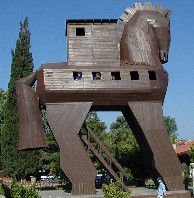 Sunday morning we got away early from our hotel in Çanakkale and went to see the site of Troy. The first thing that greets you there is the wooden horse built A.D. 1975. Its theme-park playground quality jars weirdly with the night of horror that it recalls.
Sunday morning we got away early from our hotel in Çanakkale and went to see the site of Troy. The first thing that greets you there is the wooden horse built A.D. 1975. Its theme-park playground quality jars weirdly with the night of horror that it recalls.
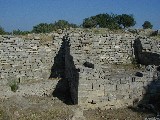
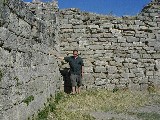 The Homerically obsessed archaeologist Heinrich Schliemann, looking for one city here, found the remains of no fewer than nine stacked up, and some of his numbered strata have since been subdivided. Probably the best candidate for Homer's Troy is the exceptionally well-established and strongly fortified Troy VI, the outer defensive walls of which are shown here. (Troy VI was apparently laid low in the end by an earthquake, though, rather than by sack and fire. One theory holds that the Achaeans had besieged it unsuccessfully till then, but rather quickly overwhelmed the hastily rebuilt settlement, Troy VIIa, which does appear to have perished in flames; they then made the horse as a thank-offering to Poseidon in his capacity as earth-shaker.)
The Homerically obsessed archaeologist Heinrich Schliemann, looking for one city here, found the remains of no fewer than nine stacked up, and some of his numbered strata have since been subdivided. Probably the best candidate for Homer's Troy is the exceptionally well-established and strongly fortified Troy VI, the outer defensive walls of which are shown here. (Troy VI was apparently laid low in the end by an earthquake, though, rather than by sack and fire. One theory holds that the Achaeans had besieged it unsuccessfully till then, but rather quickly overwhelmed the hastily rebuilt settlement, Troy VIIa, which does appear to have perished in flames; they then made the horse as a thank-offering to Poseidon in his capacity as earth-shaker.)

 These two gates also belonged to the defensive walls of Troy VI.
These two gates also belonged to the defensive walls of Troy VI.
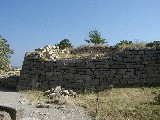
 The "palace house" seen in these photos also dates from Troy VI. It was located just within the outer defensive wall (the foundation of which is seen in the foreground at right).
The "palace house" seen in these photos also dates from Troy VI. It was located just within the outer defensive wall (the foundation of which is seen in the foreground at right).
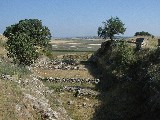

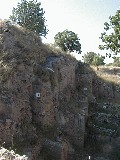 At left are some house walls from the early-bronze-age settlement Troy I (here seen at the bottom of the "Schliemann Trench," a horrifically destructive excavation), and a "chariot ramp" from Troy II. At right, major strata are numbered.
At left are some house walls from the early-bronze-age settlement Troy I (here seen at the bottom of the "Schliemann Trench," a horrifically destructive excavation), and a "chariot ramp" from Troy II. At right, major strata are numbered.
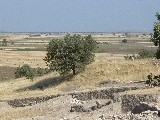 This "ruin of a ruin" is often described as disappointing, but after accordingly moderating my expectations, and after seeing many sites much less well labeled, I did not find it so. It also helps no doubt if you passionately love the Homeric epics. To me the most moving part of the whole experience, though, was looking out here over the "ringing plain of windy Troy" towards the distant Hellespont--where the Achaeans beached their ships and raised their tents--with Scamander tracing a green tree-lined furrow in the distance.
This "ruin of a ruin" is often described as disappointing, but after accordingly moderating my expectations, and after seeing many sites much less well labeled, I did not find it so. It also helps no doubt if you passionately love the Homeric epics. To me the most moving part of the whole experience, though, was looking out here over the "ringing plain of windy Troy" towards the distant Hellespont--where the Achaeans beached their ships and raised their tents--with Scamander tracing a green tree-lined furrow in the distance.

 We just managed to catch the eleven o'clock ferry across the Hellespont from Çanakkale to Eceabat. We shared the narrow waterway (also known as the Dardanelles) with many other craft including a tall ship and a submarine. All shipping between the Black Sea and the Mediterranean must pass through here, as also through the Bosphorus at Istanbul.
We just managed to catch the eleven o'clock ferry across the Hellespont from Çanakkale to Eceabat. We shared the narrow waterway (also known as the Dardanelles) with many other craft including a tall ship and a submarine. All shipping between the Black Sea and the Mediterranean must pass through here, as also through the Bosphorus at Istanbul.

 The spliced-together panorama at left, with freighter from Vladivostok, shows just how narrow is the channel that separates Europe (on the right) from Asia, and that failed to keep the valiant swimmer Leander away from his beloved Hero on the European side. The English Romantic poet Shelley died in the attempt to replicate Leander's mythic swim. Though the distance is by no means vast, perhaps he was troubled by jellyfish, which the children noticed were positively thick at either end of our passage.
The spliced-together panorama at left, with freighter from Vladivostok, shows just how narrow is the channel that separates Europe (on the right) from Asia, and that failed to keep the valiant swimmer Leander away from his beloved Hero on the European side. The English Romantic poet Shelley died in the attempt to replicate Leander's mythic swim. Though the distance is by no means vast, perhaps he was troubled by jellyfish, which the children noticed were positively thick at either end of our passage.
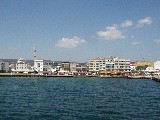
 In just minutes we landed at Eceabat. This was the town where Stas's paternal grandparents lived before the 1922 Asia Minor catastrophe, when Atatürk's new Turkish state cleansed its territory of Greeks and other ethnic minorities. It looks as if the Turks razed the place and built all new and none too prettily; as so often, only the shape of the surrounding hills would likely be recognizable to the inhabitants of the past.
In just minutes we landed at Eceabat. This was the town where Stas's paternal grandparents lived before the 1922 Asia Minor catastrophe, when Atatürk's new Turkish state cleansed its territory of Greeks and other ethnic minorities. It looks as if the Turks razed the place and built all new and none too prettily; as so often, only the shape of the surrounding hills would likely be recognizable to the inhabitants of the past.
The drive from Eceabat to Istanbul was a fast one (through much of which I kept finding myself humming a little ditty I had picked up somewhere about Instanbul versus Constantinople), and we arrived hours before we were to surrender our rental car at our reserved hotel. Finding our way to any such predetermined destination, however, proved altogether too many for us, so we opted just to stay at the first hotel we actually came to that had room for us and the car, and then call the agency to tell them where to pick it up. Even if we had been able to make better sense of maps and signs, a passerby of whom I had asked directions had led me to expect that we would face the same problem with our original reservation as we had in Rhodes--no access at all by car or even taxi. (I now believe this was misinformation in the present case.) But though we flunked navigation, I suppose I can still boast of having driven a car in Istanbul without mishap. (Actually, I think the driving experience is if anything less hairy in Istanbul and Turkey than in Athens and Greece.)
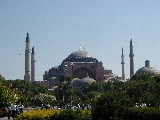
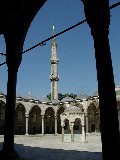 This morning we set out to tour the sights of Istanbul. The most celebrated of them all, Áyia Sofía (left), a Byzantine church turned mosque turned museum, was closed for the day. So we started with the Sultanahmet Camii or Blue Mosque. A local rug merchant appointed himself our guide as far as the courtyard, in the vain hope of our visiting his shop for tea and rug salesmanship afterwards. (This courtyard can be seen at right, lined with ornamental doors leading nowhere, and with one of the unprecedented allotment of six minarets.)
This morning we set out to tour the sights of Istanbul. The most celebrated of them all, Áyia Sofía (left), a Byzantine church turned mosque turned museum, was closed for the day. So we started with the Sultanahmet Camii or Blue Mosque. A local rug merchant appointed himself our guide as far as the courtyard, in the vain hope of our visiting his shop for tea and rug salesmanship afterwards. (This courtyard can be seen at right, lined with ornamental doors leading nowhere, and with one of the unprecedented allotment of six minarets.)

 The entrance beneath the dome seen left (part of the courtyard gallery) is reserved for the worshippers. We dutifully went round to the tourist entrance and there bagged our shoes. Seeing some fellow tourists with their legs awkwardly swathed in borrowed blue sheets, we were glad we had consulted the mosque dress code in our guidebook before setting out in the morning. Inside, we admired the blue Iznik tiles that give the place its nickname. The women in their segregated gallery (right) would have had a particularly good view of them.
The entrance beneath the dome seen left (part of the courtyard gallery) is reserved for the worshippers. We dutifully went round to the tourist entrance and there bagged our shoes. Seeing some fellow tourists with their legs awkwardly swathed in borrowed blue sheets, we were glad we had consulted the mosque dress code in our guidebook before setting out in the morning. Inside, we admired the blue Iznik tiles that give the place its nickname. The women in their segregated gallery (right) would have had a particularly good view of them.
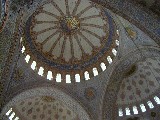
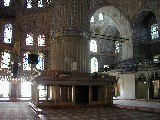 One peculiarity of the mosque environment is the lighting. Many small lamps burn on large frames hung low above the wonderful expanse of carpet, barely out of arm's reach, suspended on long wires from the high domes and semidomes. The many wires effectively curtail all imaginary soaring through the otherwise lofty space.
One peculiarity of the mosque environment is the lighting. Many small lamps burn on large frames hung low above the wonderful expanse of carpet, barely out of arm's reach, suspended on long wires from the high domes and semidomes. The many wires effectively curtail all imaginary soaring through the otherwise lofty space.

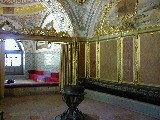
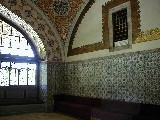 Next we walked to the Topkapi palace, the palace of the Ottoman Sultans and now a museum. It is arranged in three courtyards: the first was a regimental parade ground, the second was devoted to the kitchens and the cabinet, and the third was for the Sultan's own quarters. Here we see the second, the court of the Divan or council. Beneath the Divan tower or tower of justice, the council met and deliberated in the tiled chamber shown right, under the grilled window through which the Sultan exercised surveillance. The adjoining anteroom is beautifully paneled in colored marble.
Next we walked to the Topkapi palace, the palace of the Ottoman Sultans and now a museum. It is arranged in three courtyards: the first was a regimental parade ground, the second was devoted to the kitchens and the cabinet, and the third was for the Sultan's own quarters. Here we see the second, the court of the Divan or council. Beneath the Divan tower or tower of justice, the council met and deliberated in the tiled chamber shown right, under the grilled window through which the Sultan exercised surveillance. The adjoining anteroom is beautifully paneled in colored marble.
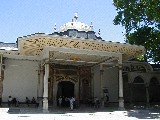 The Gate of Felicity, site of Ottoman coronations and investitures, leads from the court of the Divan to the third court, the Sultan's own quarters. The third court is the place now for the fabled jewel collection, but that whole exhibit area had been closed for renovations since January, and was supposed to reopen at the beginning of June but had not. (Perhaps they are installing new security technology, to be circumvented in the next caper film to be set here.)
The Gate of Felicity, site of Ottoman coronations and investitures, leads from the court of the Divan to the third court, the Sultan's own quarters. The third court is the place now for the fabled jewel collection, but that whole exhibit area had been closed for renovations since January, and was supposed to reopen at the beginning of June but had not. (Perhaps they are installing new security technology, to be circumvented in the next caper film to be set here.)
One amazing exhibit that was open was a collection of sacred relics assembled by the Ottomans, some of them acquired in conjunction with their takeover of the Caliphate from the Abassids of Baghdad. These include keys, rain gutters, and a door from the Kaaba shrine in Mecca, and numerous relics of the prophet Mohammed, including casts or carvings of his footprint, ashes from his grave, a broken tooth and some hairs from his beard, and two swords with scabbards and a bow with bow case. There was also an exquisite scale model of the Dome of the Rock in Jerusalem, about two feet square and a foot and a half high, executed entirely in mother-of-pearl. This particular suite is a site of Muslim pilgrimage, so no photographs were allowed inside, in contrast even with the mosques we visited today. While we were there, a young man seated himself in a glass booth in a corner of one of the rooms, donned a special fez, and began intoning a passage from the book in front of him over a public address system.
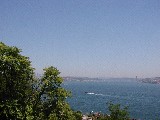 The palace sits on an eminence commanding prospects of Istanbul's great waterways: the Golden Horn (going off left behind the trees), and the Bosphorus (right, spanned by a suspension bridge). Just across the Bosphorus is the site of ancient Chalcedon, home town of the sophist Thrasymachus, who cuts a formidable figure in Book I of Plato's Republic, arguing that "justice" is merely the interest of the stronger party.
The palace sits on an eminence commanding prospects of Istanbul's great waterways: the Golden Horn (going off left behind the trees), and the Bosphorus (right, spanned by a suspension bridge). Just across the Bosphorus is the site of ancient Chalcedon, home town of the sophist Thrasymachus, who cuts a formidable figure in Book I of Plato's Republic, arguing that "justice" is merely the interest of the stronger party.
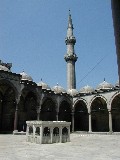
 Next we took a taxi to visit the beautiful Sülimaniye mosque. This is an acknowledged masterpiece by the most famous of Ottoman mosque architects, Mimar Sinan, who rose to eminence in that capacity from the ranks of the Greek boys seized from their families to be raised as Turks and become Janissaries. He lived and worked in the time of Süleyman the Magnificent (sixteenth century).
Next we took a taxi to visit the beautiful Sülimaniye mosque. This is an acknowledged masterpiece by the most famous of Ottoman mosque architects, Mimar Sinan, who rose to eminence in that capacity from the ranks of the Greek boys seized from their families to be raised as Turks and become Janissaries. He lived and worked in the time of Süleyman the Magnificent (sixteenth century).
 We wrapped up our afternoon with a visit to the Grand (covered) Bazaar.
We wrapped up our afternoon with a visit to the Grand (covered) Bazaar.
previous entry
next entry
main/ToC page

 The Homerically obsessed archaeologist Heinrich Schliemann, looking for one city here, found the remains of no fewer than nine stacked up, and some of his numbered strata have since been subdivided. Probably the best candidate for Homer's Troy is the exceptionally well-established and strongly fortified Troy VI, the outer defensive walls of which are shown here. (Troy VI was apparently laid low in the end by an earthquake, though, rather than by sack and fire. One theory holds that the Achaeans had besieged it unsuccessfully till then, but rather quickly overwhelmed the hastily rebuilt settlement, Troy VIIa, which does appear to have perished in flames; they then made the horse as a thank-offering to Poseidon in his capacity as earth-shaker.)
The Homerically obsessed archaeologist Heinrich Schliemann, looking for one city here, found the remains of no fewer than nine stacked up, and some of his numbered strata have since been subdivided. Probably the best candidate for Homer's Troy is the exceptionally well-established and strongly fortified Troy VI, the outer defensive walls of which are shown here. (Troy VI was apparently laid low in the end by an earthquake, though, rather than by sack and fire. One theory holds that the Achaeans had besieged it unsuccessfully till then, but rather quickly overwhelmed the hastily rebuilt settlement, Troy VIIa, which does appear to have perished in flames; they then made the horse as a thank-offering to Poseidon in his capacity as earth-shaker.)
 Sunday morning we got away early from our hotel in Çanakkale and went to see the site of Troy. The first thing that greets you there is the wooden horse built A.D. 1975. Its theme-park playground quality jars weirdly with the night of horror that it recalls.
Sunday morning we got away early from our hotel in Çanakkale and went to see the site of Troy. The first thing that greets you there is the wooden horse built A.D. 1975. Its theme-park playground quality jars weirdly with the night of horror that it recalls.



























